COURSE
MATERIAL INVESTIGATIONS
University of Basel, Urban Studies, MA Critical Urbanisms, Fall 2023
Fabrizio Furiassi
Guest Lecturer: Prof. Sarah Nichols, EPFL
OVERVIEW
''The study of cities and landscapes has certainly the most tangible material focus in all social sciences. No matter what cities and landscapes are examined, there is absolutely no question about their physicality in the form of buildings, infrastructures, and environments. However, cities and landscapes have also been the sites where immaterial entities, like capitals, social structures, and political forces, have been most manifest. Twentieth-century scholars tended to prioritize the study of the immaterial, conceptual dimensions of space over tangible ones. Yet, stemming from theories and methods of the material turn in the social sciences, the inclination to see material and immaterial worlds as separate spheres of study started to shift towards new relational perspectives. This course will provide a forum to debate these new perspectives that are emerging through a growing body of literature in architecture and urban studies.
CONCRETE IN SWITZERLAND
The course will focus on the assessment of one of the most controversial building materials: concrete. This starts with an analysis of the impact of concrete on the environmental and cultural transformations of the territory in Switzerland during the twentieth century, linked to innovations in the construction sector and the wide availability of local cement. Indeed, concrete has significantly transformed the Swiss landscape through infrastructure development and knowledge reorganization. This course will explore today’s implications of these transformations by examining existing concrete buildings in Basel and Switzerland and how they participate in both disciplinary and non-disciplinary discourses and controversies.
CONCRETE: THE SOCIALLY CONSTRUCTED CONSTRUCTION MATERIAL
Construction materials are often studied for their technological properties and construction capabilities. This course examines them in a different way: as complex systems of social relations. This social dimension of concrete will help us understand how the construction material organizes, supports, and informs the agency of social actors shaping the built environment and their role in historical change, as well as the agency of the material in its own right. This course focuses on the history of concrete in Switzerland and its role in the modernization of the country as a key material for the construction of iconic structures and revolutionizing design, defining Swiss architecture and urbanism.'' Fabrizio Furiassi
MA Critical Urbanism-University of Basel
MA Critical Urbanisms - Instagram
POLLUX'S SPEARS
Prepared for one of the course assessments

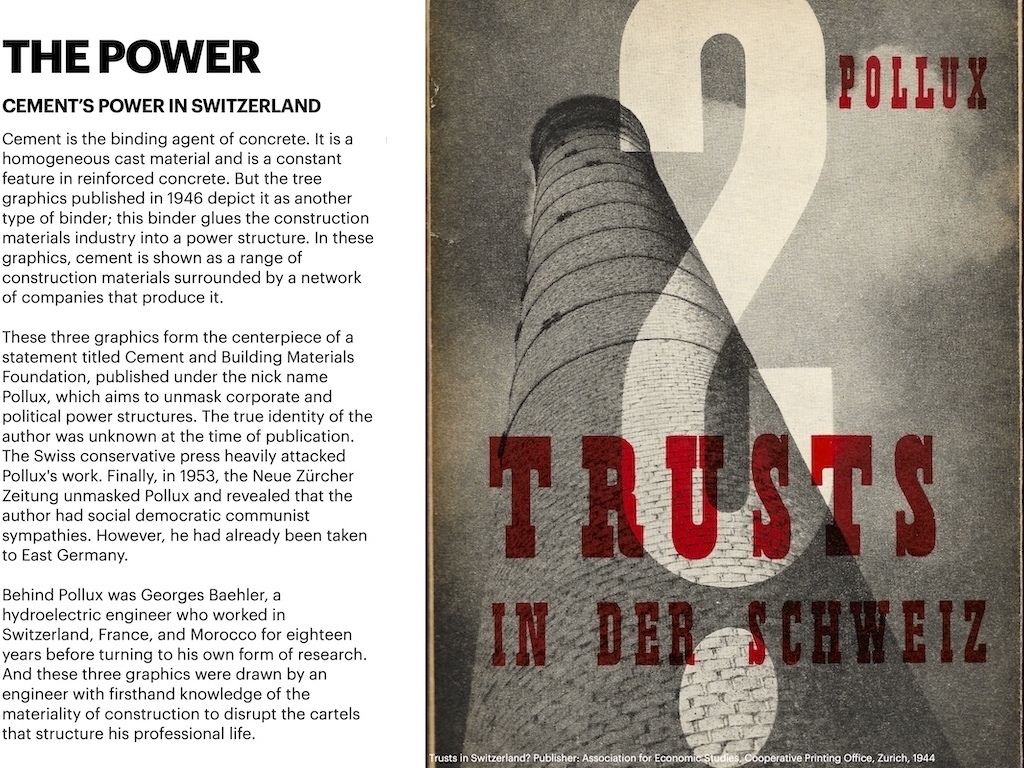
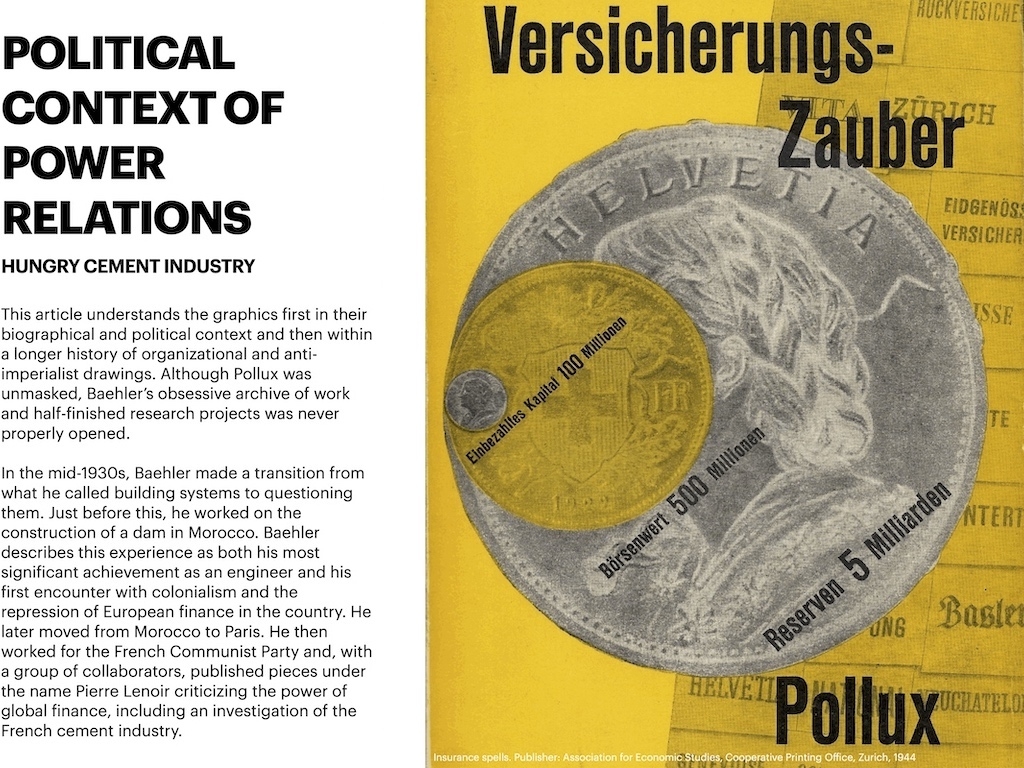
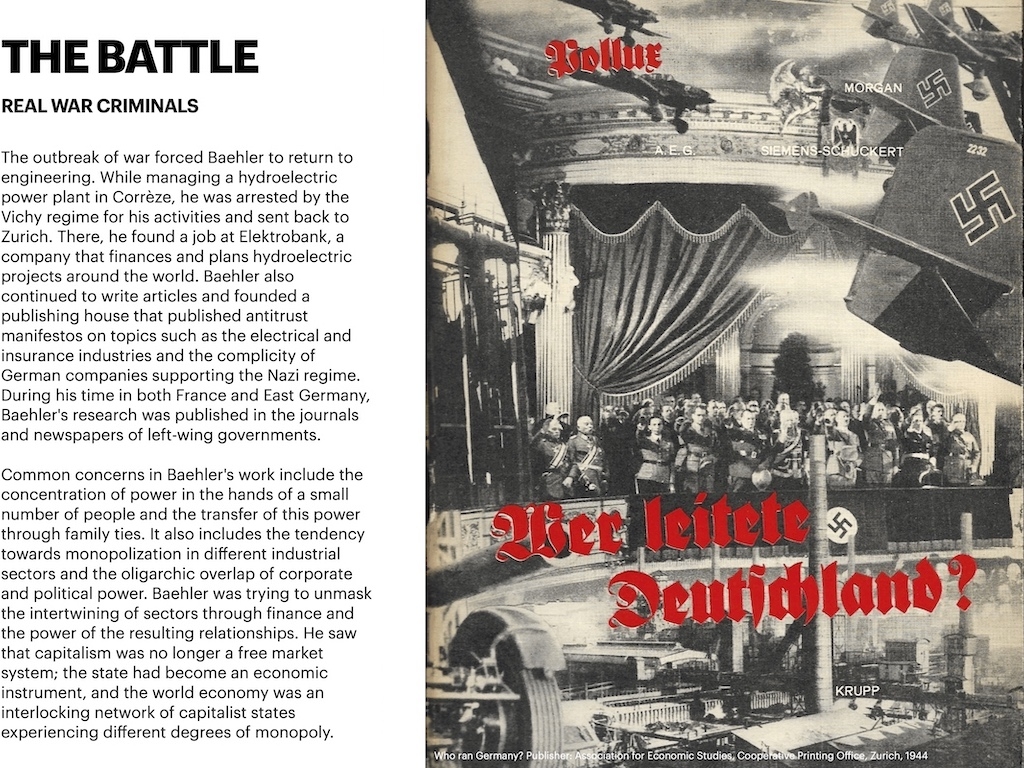
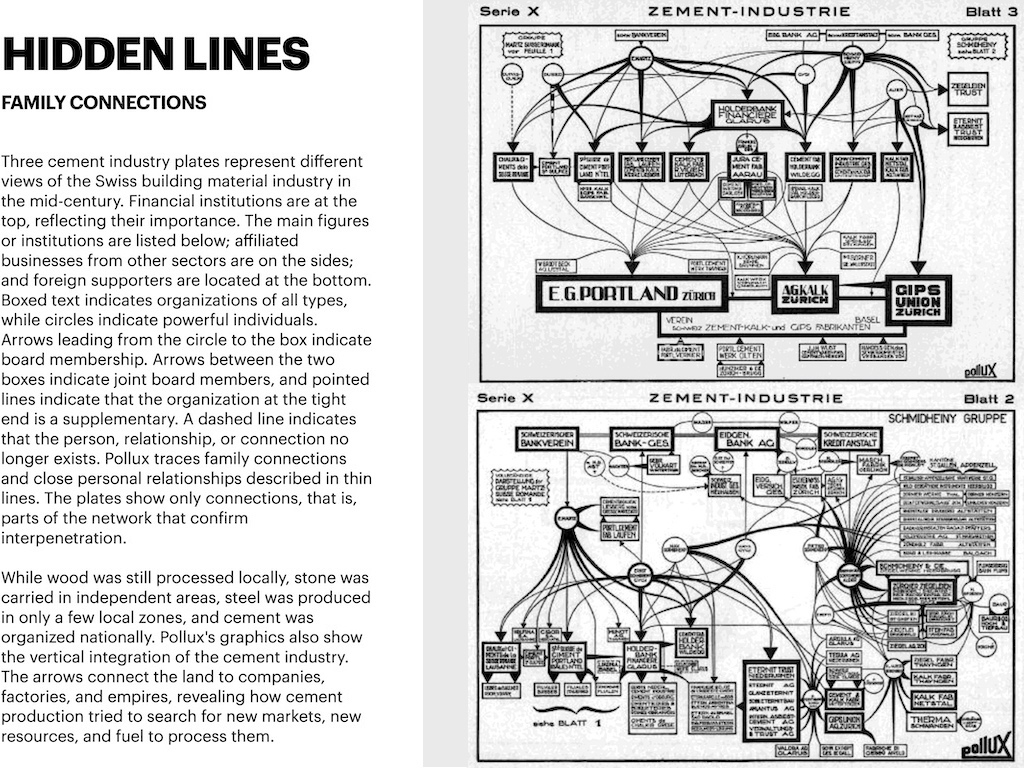
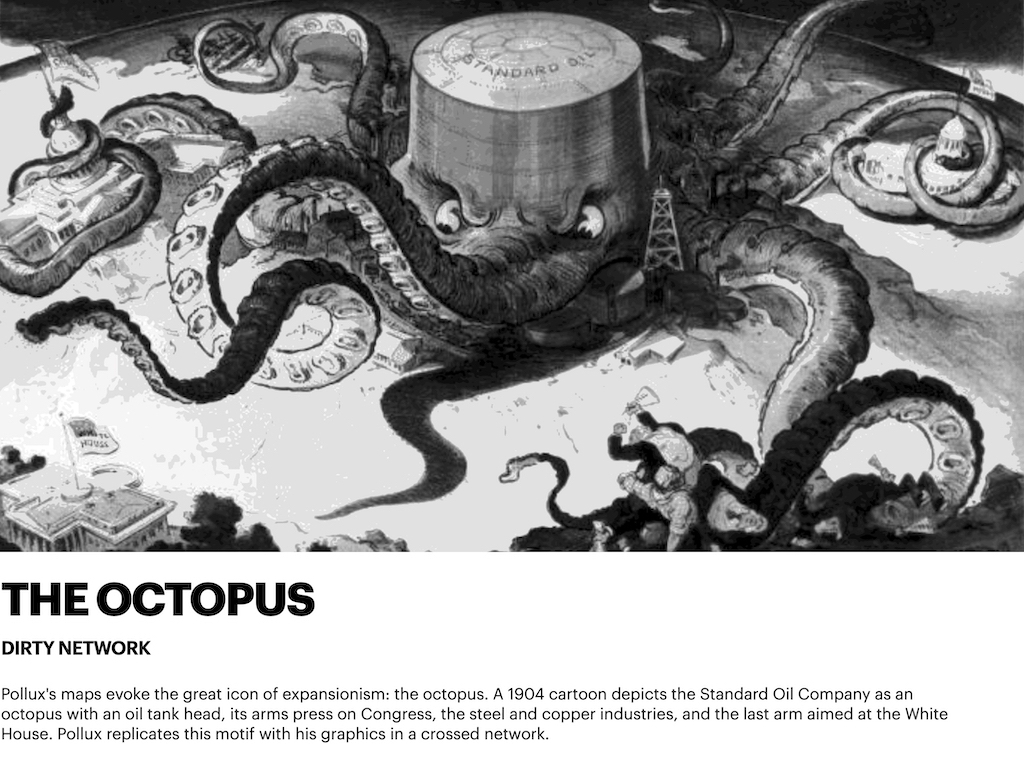
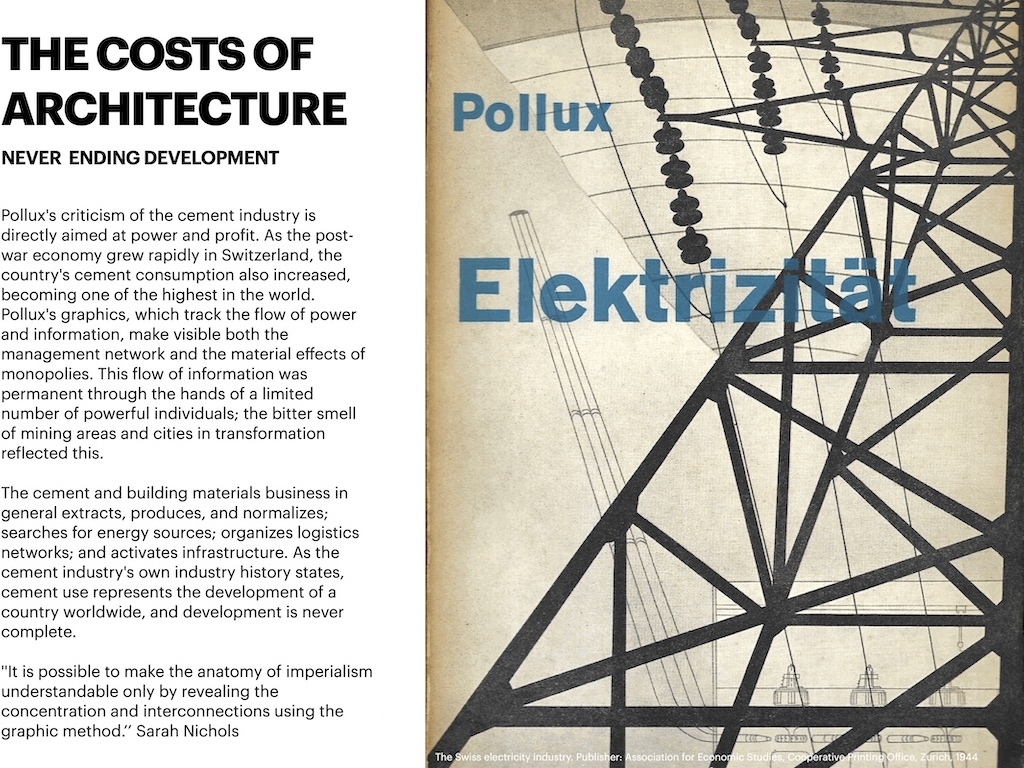
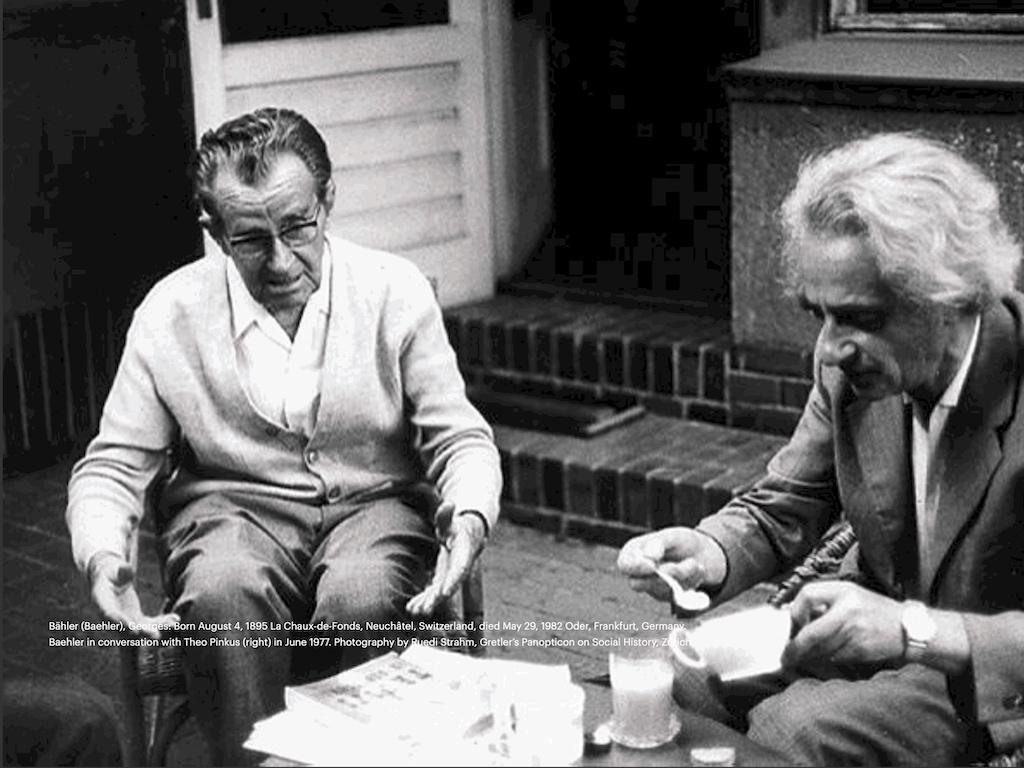
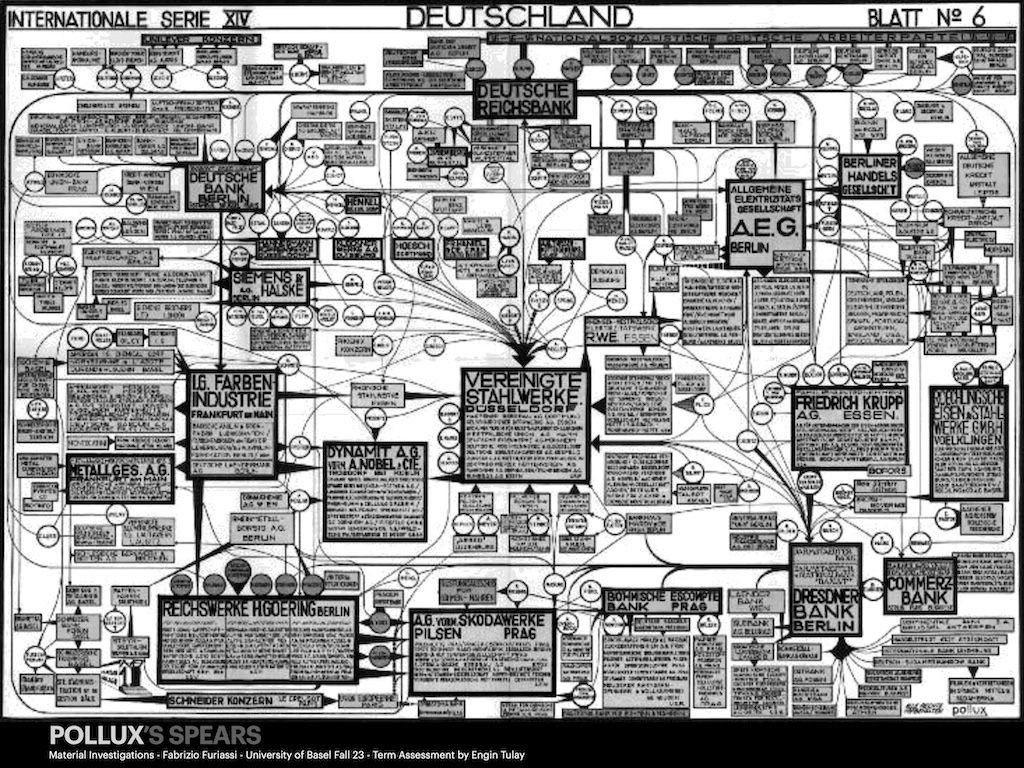
Nichols, Sarah. “Pollux Spears,” in Grey Room 71 (Spring 2018), pp. 141-155
POLLUX'S SPEARS
THE POWER
CEMENT’S POWER IN SWITZERLAND
Cement is the binding agent of concrete. It is a homogeneous cast material and is a constant feature in reinforced concrete. But the tree graphics published in 1946 depict it as another type of binder; this binder glues the construction materials industry into a power structure. In these graphics, cement is shown as a range of construction materials surrounded by a network of companies that produce it.
These three graphics form the centerpiece of a statement titled Cement and Building Materials Foundation, published under the nick name Pollux, which aims to unmask corporate and political power structures. The true identity of the author was unknown at the time of publication. The Swiss conservative press heavily attacked Pollux's work. Finally, in 1953, the Neue Zürcher Zeitung unmasked Pollux and revealed that the author had social democratic communist sympathies. However, he had already been taken to East Germany.
Behind Pollux was Georges Baehler, a hydroelectric engineer who worked in Switzerland, France, and Morocco for eighteen years before turning to his own form of research. And these three graphics were drawn by an engineer with firsthand knowledge of the materiality of construction to disrupt the cartels that structure his professional life.
POLITICAL CONTEXT OF POWER RELATIONS
HUNGRY CEMENT INDUSTRY
This article understands the graphics first in their biographical and political context and then within a longer history of organizational and anti- imperialist drawings. Although Pollux was unmasked, Baehler’s obsessive archive of work and half-finished research projects was never properly opened.
In the mid-1930s, Baehler made a transition from what he called building systems to questioning them. Just before this, he worked on the construction of a dam in Morocco. Baehler describes this experience as both his most significant achievement as an engineer and his first encounter with colonialism and the repression of European finance in the country. He later moved from Morocco to Paris. He then worked for the French Communist Party and, with a group of collaborators, published pieces under the name Pierre Lenoir criticizing the power of global finance, including an investigation of the French cement industry.
THE BATTLE
REAL WAR CRIMINALS
The outbreak of war forced Baehler to return to engineering. While managing a hydroelectric power plant in Corrèze, he was arrested by the Vichy regime for his activities and sent back to Zurich. There, he found a job at Elektrobank, a company that finances and plans hydroelectric projects around the world. Baehler also continued to write articles and founded a publishing house that published antitrust manifestos on topics such as the electrical and insurance industries and the complicity of German companies supporting the Nazi regime. During his time in both France and East Germany, Baehler's research was published in the journals and newspapers of left-wing governments.
Common concerns in Baehler's work include the concentration of power in the hands of a small number of people and the transfer of this power through family ties. It also includes the tendency towards monopolization in different industrial sectors and the oligarchic overlap of corporate and political power. Baehler was trying to unmask the intertwining of sectors through finance and the power of the resulting relationships. He saw that capitalism was no longer a free market system; the state had become an economic instrument, and the world economy was an interlocking network of capitalist states experiencing different degrees of monopoly.
HIDDEN LINES
FAMILY CONNECTIONS
Three cement industry plates represent different views of the Swiss building material industry in the mid-century. Financial institutions are at the top, reflecting their importance. The main figures or institutions are listed below; affiliated businesses from other sectors are on the sides; and foreign supporters are located at the bottom. Boxed text indicates organizations of all types, while circles indicate powerful individuals. Arrows leading from the circle to the box indicate board membership. Arrows between the two boxes indicate joint board members, and pointed lines indicate that the organization at the tight end is a supplementary. A dashed line indicates that the person, relationship, or connection no longer exists. Pollux traces family connections and close personal relationships described in thin lines. The plates show only connections, that is, parts of the network that confirm interpenetration.
While wood was still processed locally, stone was carried in independent areas, steel was produced in only a few local zones, and cement was organized nationally. Pollux's graphics also show the vertical integration of the cement industry. The arrows connect the land to companies, factories, and empires, revealing how cement production tried to search for new markets, new resources, and fuel to process them.
THE OCTOPUS
DIRTY NETWORK
Pollux's maps evoke the great icon of expansionism: the octopus. A 1904 cartoon depicts the Standard Oil Company as an octopus with an oil tank head, its arms press on Congress, the steel and copper industries, and the last arm aimed at the White House. Pollux replicates this motif with his graphics in a crossed network.
THE COSTS OF ARCHITECTURE
NEVER ENDING DEVELOPMENT
Pollux's criticism of the cement industry is directly aimed at power and profit. As the post- war economy grew rapidly in Switzerland, the country's cement consumption also increased, becoming one of the highest in the world. Pollux's graphics, which track the flow of power and information, make visible both the management network and the material effects of monopolies. This flow of information was permanent through the hands of a limited number of powerful individuals; the bitter smell of mining areas and cities in transformation reflected this.
The cement and building materials business in general extracts, produces, and normalizes; searches for energy sources; organizes logistics networks; and activates infrastructure. As the cement industry's own industry history states, cement use represents the development of a country worldwide, and development is never complete.
''It is possible to make the anatomy of imperialism understandable only by revealing the concentration and interconnections using the graphic method.’’ Sarah Nichols